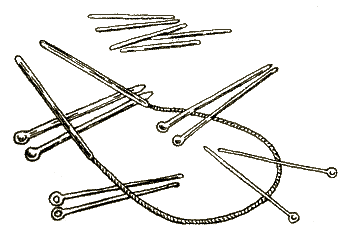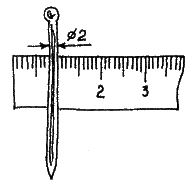Aluminum knitting needles oxidize and stain the white products, so these make the spokes with electroplating. Spokes with electroplating aesthetic and comfortable when knitting.

Figure 12. Set of needles for knitting
Steel spokes heavy, but in the process, they quickly get used to and not notice their weaknesses.
Each knitting needles your the number that corresponds to its diameter in mm. for Example: the diameter of the knitting needles No. 2 - 2 mm (figure 13).

Figure 13. Measuring the thickness of the spokes
The number of spokes is chosen considering the thickness of yarn. The diameter of the spokes should be on the number 1 thicker strand of yarn. To determine the number of spokes, you are going to use when knitting products, to fold the thread 2 times and twist. The thickness of the twisted yarn should equal the diameter of knitting needles.
Each knitter produces individual manner (one more, another less tight). Depending on the manner of mating is necessary to select the numbers of the spokes. Mismatched knitting needles make knitting or dense, tight, or too loose. When there is an error in the choice of the number of spokes does not work elastic knit.
For learning and work the necessary set of spokes from 1 to 5.5 mm. knitting Needles should be short and long with beads or rings at the ends. These spokes have one working end. Work horses of the spokes should be rounded and not pricking your finger. But if the end of the spoke is too blunt, it doesn't capture the loop when knitting.
For knitting socks, mittens, etc. requires a set of five spokes. For models with a large number of loops used needles with nylon fishing line or PVC pipe.



